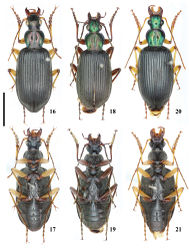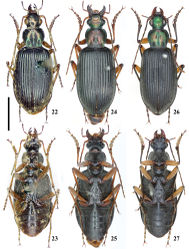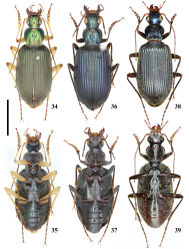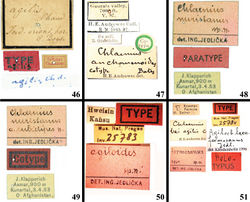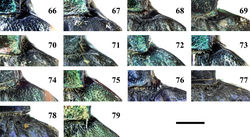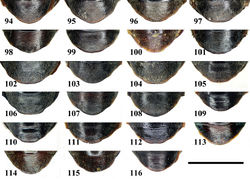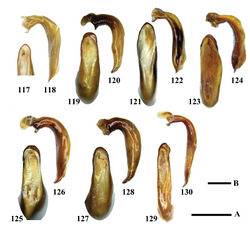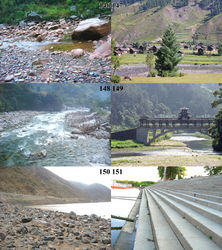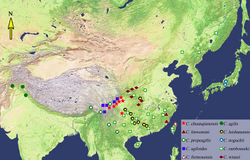Chlaenius (Lithochlaenius) agilis
| Notice: | This page is derived from the original publication listed below, whose author(s) should always be credited. Further contributors may edit and improve the content of this page and, consequently, need to be credited as well (see page history). Any assessment of factual correctness requires a careful review of the original article as well as of subsequent contributions.
If you are uncertain whether your planned contribution is correct or not, we suggest that you use the associated discussion page instead of editing the page directly. This page should be cited as follows (rationale):
Citation formats to copy and paste
BibTeX: @article{Liu2011ZooKeys128, RIS/ Endnote: TY - JOUR Wikipedia/ Citizendium: <ref name="Liu2011ZooKeys128">{{Citation See also the citation download page at the journal. |
Ordo: Coleoptera
Familia: Carabidae
Name
Chlaenius agilis Chaudoir – Wikispecies link – Pensoft Profile
- Chlaenius latro LaFerté-Sénectère, 1851:250 (unavailable). Nomen nudum stat. n.
- Chlaenius agilis Chaudoir, 1856:246; 1876:193; Kryzhanovskij, 1976:12
- Chlaenius anchomenoides Bates, 1889:212; Kirschenhofer, 1997:116; Kirschenhofer, 2005:490. syn. n.
- Chlaenius nuristanus Jedlička, 1956:194; Kirschenhofer, 2005:490. syn. n.
- Chlaenius nuristanus a. rubridipes Jedlička, 1956:194 (not available, ICZN Articles 10A and 45.6.2).
- Stenochlaenius anchomenoides Bates: Mandl, 1972:104
Specimens examined
Total 15 specimens. India: type: male (MNHN), "agilis Chaud, Ind. orient bor. C. Boys.”/ "TYPE agilis”/ "Ex Musaeo Chaudoir”/ "agilis Chd”; Cotype: female (MNHN), "agilis Chaud, Ind. orient bor. C. Boys.”/ "TYPE agilis”/ "Ex Musaeo Chaudoir”/ "agilis Chd” ; Cotype: male (MNHN), "agilis Chaud, Ind. orient bor. C. Boys.”/ "latro”; 2 males and 3 females (CASC), "Bajaura, Kongra district (Indes Angl.)”/ "G. Babault, Juin 1914”/ "van Dyke collection”/ "Chlaenius agilis, Chaud., H.E. Andrewes det.”. 1 female (CASC), "W. Almora Divn, Kumaon U.P., Apr. 1917, HGC.”/ "Van Dyke Collection”. Pakistan: Cotype: 2 males (BMNH), "Goorais valley, 7000ft, V. 87”/ "H. E. Andrews Coll. B. M. 1945–97”/ "Ex coll. R. Oberthür”/ "Chlaenius anchomenoides Bates, cotype, H. E. Andrews det.”/ "Co-type”. Afghanistan: 1 female (MNHN), "J. Klapperich, Bashgultal, 1100m, Nuristan, 22.4.53, Afghanistan”/ "Chlaenius nuristanus sp. n, det. ING. JEDLICKA”/ "Type”;
Paratype: 2 males (MNHN), "J. Klapperich, Asmar, 900m, Kunartal, 3.4.53, O-Afghanistan”/ "Chlaenius nuristanus sp.n, det. ING. JEDLICKA”/ "PARATYPE”; Type: 1 male (MNHN), "J. Klapperich, Asmar, 900m, Kunartal, 3.4.53, O-Afghanistan”/ "Chlaenius nuristanus a. rubridipes n. det. ING. JEDLICKA”/ "TYPUS”; Cotype: 1 male (MNHN), "J. Klapperich, Asmar, 900m, Kunartal, 3.4.53, O-Afghanistan”/ "Chlaenius nuristanus a. rubridipes n. det. ING. JEDLICKA”/ "Cotype”.
Diagnosis
Antennomere 1 elongate ovoid (Figs 55, 62–64); basal two-thirds of intervals 1–5 glabrous medially, with one row of pubescence laterally near striae (Figs 83, 90–92); aedeagus abruptly bent near base (Figs 124, 139, 141, 143).
Description
Total length = 15.50–16.00 mm (mean = 15.50), width = 5.60–6.10 mm (mean = 5.73); HW = 2.75–2.95 mm (mean = 2.82), EYL = 1.00–1.15 mm (mean =1.00), ratio Ant3/Ant1 = 1.67–1.83 (mean = 1.71), PL/PW = 0.84–0.85 (mean = 0.85), EL/EW = 1.63–1.73 (mean = 1.71), EYL/ PL = 1.15–1.44 (mean = 1.34). Mensural data cited in the description were obtained from type and cotype specimens examined.
Head, pronotum and elytra black, with green or blue metallic luster; ventral surface black; mandibles and trochanters dark brown; palpomeres, femora, and tarsomeres brown to dark brown; antennae and tibiae yellow to brown (Figs 22–23, 36–41).
Head with vertex smooth or very sparsely punctate behind eyes; antennomere 1 elongate ovoid (Figs 55, 62–64); labrum slightly emarginate at apex. Pronotum with disk smooth; basal foveae deep, sparsely punctate and pubescent (Figs 22, 36, 38, 40). Elytra with intervals convex, basal two-thirds of intervals 1–5 glabrous medially, with one row of pubescence laterally near striae (Figs 83, 90–92), intervals 6–9 and apical one-third of intervals 1–5 densely pubescent; striae deep, punctate; humeral angle obtuse (Figs 69, 76–78). Abdominal sterna IV–VI sparsely pubescent medially; sternum VII rugose–pubescent, narrowly rounded apically in males (Figs 100, 113–114), broadly rounded apically in females (Fig. 115). Aedeagus abruptly bent near base, apical lamella round (Figs 123, 138, 140, 142), thin and slight bent ventrally (Figs 124, 139, 141, 143).
Color variation
Color of antennae, palpomeres, femora, and tibiae varied from medium brown to dark brown or even black among different individuals (Figs 22–23, 36–41).
Geographical distribution
Fig. 158. Known only from eastern Afghanistan, Pakistan, and northern India.
Remarks
Mensural data cited in the description were obtained from type and cotype specimens examined. The name Chlaenius agilis Chaudoir was once treated as a junior synonym of Chlaenius latro LaFerté–Sénectère (Csiki 1931[1], Kirschenhofer 1997[2]). However, in his work, LaFerté–Sénectère (1851)[3] did not provide a specific description of Chlaenius latro. This means that Chlaenius latro LaFerté–Sénectère is a nomen nudum, and therefore, unavailable.
Kirschenhofer (2005)[4] considered Chlaenius nuristanusJedlička to be a junior synonym of Chlaenius anchomenoides Bates. We have examined the types and/or cotypes of Chlaenius agilis Chaudoir, Chlaenius anchomenoides, Chlaenius nuristanus and its aberration Chlaenius nuristanusa.rubridipes, and found no significant differences between them, except for variation in the color of antennae and legs. The aedeagi are abruptly bent near the base in all dissected males (Figs 124, 139, 141, 143).
Mandl (1972: 104)[5] assigned Chlaenius anchomenoides to genus Stenochlaenius. Based on the pubescent elytral intervals and incomplete elytral basal margin in members of Chlaenius anchomenoides, we do not agree with this assignment.
Taxon Treatment
- Liu, Y; Kavanaugh, D; Shi, H; Liang, H; 2011: A key to species of subgenus Lithochlaenius (Coleoptera, Carabidae, Chlaeniini, Chlaenius), with descriptions of three new species ZooKeys, 128: 15-52. doi
Other References
- ↑ Csiki E (1931) Carabidae: Harpalinae V (Pars 115). In: Junk W Schenkling S (Eds). Coleopterorum catalogus. Volumen II. Carabidae II, W. Junk, Berlin: 739-1022.
- ↑ Kirschenhofer E (1997) Contribution to the faunistics and taxonomy of Carabidae (Coleoptera) of Korea. Annales Historico-Naturales Musei Nationalis Hungarici 89: 103-122.
- ↑ LaFerté–Sénectère F (1851) Revision de la tribu des patellimanes de Dejean, coléoptères pentameres de la famille des carabiques. Annales de la Société Entomologique de France (2) 9: 209–294.
- ↑ Kirschenhofer E (2005) Weiter neue Arten der Gattung Chlaenius Bonelli 1810 aus China, Myanmar und Indien (Coleoptera, Carabidae). Linzer Biologische Beiträge 37: 489-501.
- ↑ Mandl K (1972) Beitrag zur Kenntnis des Genus Stenochlaenius Reitter. Die Arten der Gruppe coeruleus Steven. (Col. Carabidae). Nachrichtenblatt der Bayerischen Entomologen 21: 97-105.
Images
|
